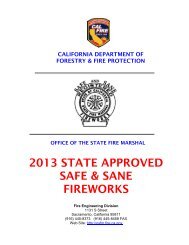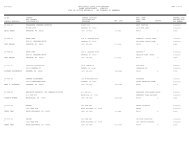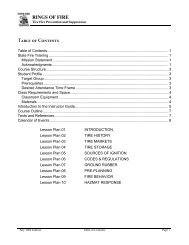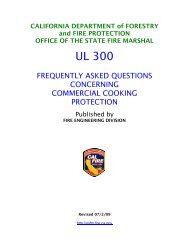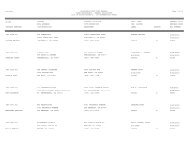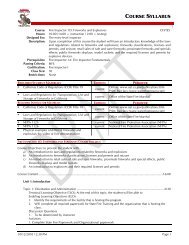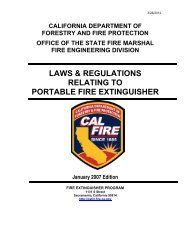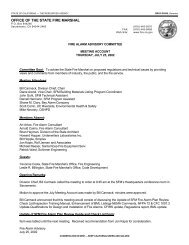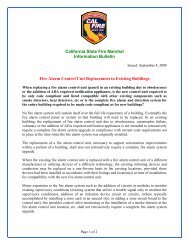draft - Office of the State Fire Marshal - State of California
draft - Office of the State Fire Marshal - State of California
draft - Office of the State Fire Marshal - State of California
You also want an ePaper? Increase the reach of your titles
YUMPU automatically turns print PDFs into web optimized ePapers that Google loves.
emote mechanical operating release shall be provided.<br />
DRAFT<br />
Exception: Emergency power is not required in facilities where provisions for remote locking and unlocking <strong>of</strong><br />
occupied rooms in Occupancy Condition 4 are not required as set forth in <strong>the</strong> International <strong>California</strong> Building Code.<br />
605.3 Working space and clearance. A working space <strong>of</strong> not less than 30 inches (762 mm) in width, 36 inches (914<br />
mm) in depth and 78 inches (1981 mm) in height shall be provided in front <strong>of</strong> electrical service equipment. Where <strong>the</strong><br />
electrical service equipment is wider than 30 inches (762 mm), <strong>the</strong> working space shall not be less than <strong>the</strong> width <strong>of</strong><br />
<strong>the</strong> equipment. No storage <strong>of</strong> any materials shall be located within <strong>the</strong> designated working space.<br />
Exceptions:<br />
1. Where o<strong>the</strong>r dimensions are required or allowed by <strong>the</strong> NFPA 70 <strong>California</strong> Electrical Code.<br />
2. Access openings into attics or under-floor areas which provide a minimum clear opening <strong>of</strong> 22 inches (559 mm) by<br />
30 inches (762 mm).<br />
605.4 Multiplug adapters. Multiplug adapters, such as cube adapters, unfused plug strips or any o<strong>the</strong>r device not<br />
complying with <strong>the</strong> NFPA 70 <strong>California</strong> Electrical Code shall be prohibited.<br />
605.9 Temporary wiring. Temporary wiring for electrical power and lighting installations is allowed for a period not to<br />
exceed 90 days. Temporary wiring methods shall meet <strong>the</strong> applicable provisions <strong>of</strong> <strong>the</strong> NFPA 70 <strong>California</strong> Electrical<br />
Code.<br />
Exception: Temporary wiring for electrical power and lighting installations is allowed during periods <strong>of</strong> construction,<br />
remodeling, repair or demolition <strong>of</strong> buildings, structures, equipment or similar activities.<br />
[M] 606.1 Scope. Refrigeration systems shall be installed in accordance with <strong>the</strong> International <strong>California</strong> Mechanical<br />
Code.<br />
[M] 606.2 Refrigerants. The use and purity <strong>of</strong> new, recovered, and reclaimed refrigerants shall be in accordance with<br />
<strong>the</strong> International <strong>California</strong> Mechanical Code.<br />
[M] 606.3 Refrigerant classification. Refrigerants shall be classified in accordance with <strong>the</strong> International <strong>California</strong><br />
Mechanical Code.<br />
[M] 606.4 Change in refrigerant type. A change in <strong>the</strong> type <strong>of</strong> refrigerant in a refrigeration system shall be in<br />
accordance with <strong>the</strong> International <strong>California</strong> Mechanical Code.<br />
606.7 Emergency signs. Refrigeration units or systems having a refrigerant circuit containing more than 220 pounds<br />
(100 kg) <strong>of</strong> Group A1 or 30 pounds (14 kg) <strong>of</strong> any o<strong>the</strong>r group refrigerant shall be provided with approved emergency<br />
signs, charts, and labels in accordance with NFPA704. Hazard signs shall be in accordance with <strong>the</strong> International<br />
<strong>California</strong> Mechanical Code for <strong>the</strong> classification <strong>of</strong> refrigerants listed <strong>the</strong>rein.<br />
606.8 Refrigerant detector. Machinery rooms shall contain a refrigerant detector with an audible and visual alarm.<br />
The detector, or a sampling tube that draws air to <strong>the</strong> detector, shall be located in an area where refrigerant from a<br />
leak will concentrate. The alarm shall be actuated at a value not greater than <strong>the</strong> corresponding TLV-TWA values<br />
shown in <strong>the</strong> International <strong>California</strong> Mechanical Code for <strong>the</strong> refrigerant classification. Detectors and alarms shall be<br />
placed in approved locations. The detector shall transmit a signal to an approved location.<br />
606.16 Electrical equipment. Where refrigerants <strong>of</strong> Groups A2, A3, B2 and B3, as defined in <strong>the</strong> International<br />
<strong>California</strong> Mechanical Code, are used, refrigeration machinery rooms shall conform to <strong>the</strong> Class I, Division 2<br />
hazardous location classification requirements <strong>of</strong> <strong>the</strong> NFPA 70 <strong>California</strong> Electrical Code.<br />
Exception: Ammonia machinery rooms that are provided with ventilation in accordance with Section 1106.3 <strong>of</strong> <strong>the</strong><br />
International <strong>California</strong> Mechanical Code.<br />
607.4 607.5 Shunt trip. Where elevator hoistways or elevator machine rooms containing elevator control equipment<br />
<strong>Office</strong> <strong>of</strong> <strong>the</strong> <strong>State</strong> <strong>Fire</strong> <strong>Marshal</strong> 32 <strong>of</strong> 191 April 30, 2009<br />
2009 Annual Rulemaking Cycle<br />
Express Terms – CCR, Title 24, Part 9<br />
2010 <strong>California</strong> <strong>Fire</strong> Code (2009 IFC)



